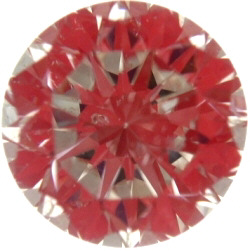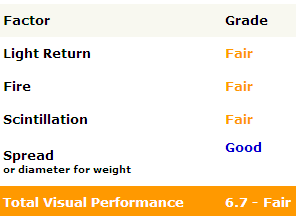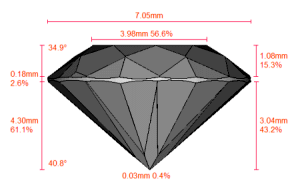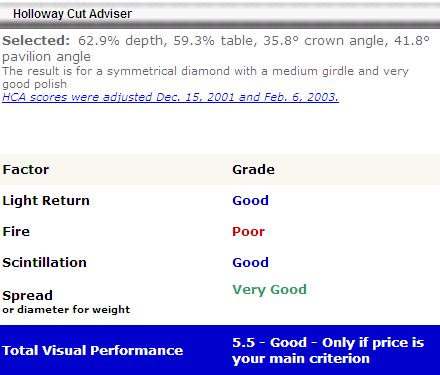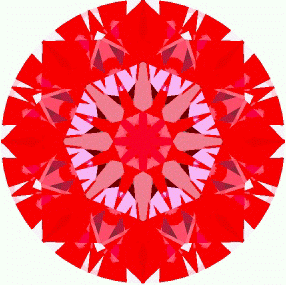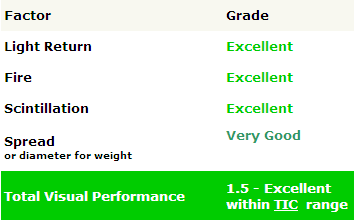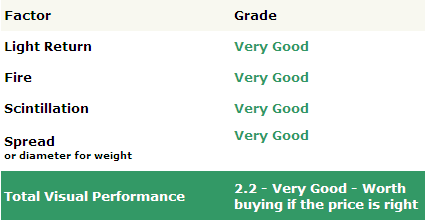HCA - A CONSUMERS GUIDE
Of all of the tools/technologies available to Internet diamond shoppers today one of the most popular tools available to consumers is what is known as the "HCA". This is short for the "Holloway Cut Advisor" named after its inventor Garry Holloway FGAA, DipDT, JAA Appraiser who is an Australian gemologist and jewelry store owner. The HCA is a free tool available to any consumer who is looking to get an idea of Garry's interpretation of a good cut quality. Garry is a colleague of mine who often participates on the PriceScope forums and is knowledgeable and experienced in the arena of cut grading and diamond quality analysis and has been in the trade since 1974. The popularity of online forums and particularly the PriceScope forum has given this tool the popularity it has gained over the course of time as regulars there use it on a daily basis and often refer new consumers to it to help weed out what is perceived to be good diamonds from bad ones. As a gemologist and frequent user of modern technologies in the assessment of diamond cut quality, my goal in this article is to examine both the strengths and the limitations of the HCA and how it can both help and in some instances hinder/confuse a consumers purchasing decision. For those not desiring to read through the entirety of this article here is a quick summary of the strengths and limitations addressed in this article.
Strengths
- - An Excellent HCA score (0-2) = an excellent reflector image.
- - An Excellent HCA score (0-2) = a diamond with minimal to no leakage via a reflector analysis, hence ...
- - The HCA offers a critical exam of what angle combinations produce leakage in diamonds (particularly under the table). Diamonds termed as "steep/deeps" (steep crown angles combined with steep pavilion angles produce light leakage in diamonds which the HCA easily and accurately identifies).
- - Many diamonds with excellent reflector images are good looking stones.
- - The HCA favors non-AGS Ideal/ GIA Ex shallow angled diamonds which in many instances are very bright and fiery diamonds.
- - Excellent for determining diamond appearance in spot lighting environments (fire) even if the diamond suffers in brightness.
Limitations
- - Not all seemingly good reflector images = the most beautiful diamond.
- - The HCA favors shallow angled diamonds while there are many proportion combinations it rewards that lack brightness.
- - While the HCA does a great job of critically determining the presence of leakage under the table, there are many instances where this leakage is not visible or perceptible to human vision.
- - Nature of scintillation not determined (broad flash vs pin flash).
- -The HCA score can change (dramatically sometimes) depending on the scanner and/or Lab Report you are garnering the numbers from.
- - The HCA predicts light performance and is not a live analysis.
- - The HCA arrives at its conclusion based on the average measurements of only 17 out of 57 facets. Minor facets measurements on the lower girdles, upper girdles and stars (40 of 57 facets) impact diamond appearance and could sway a persons decision one way or another and even affect a final cut grade from GIA or AGS.
- - The HCA does not take into account painting and digging (minor facet cutting which disqualify stones from getting AGS Ideal or GIA Excellent rating/status).
- - The HCA does not take into account the variances which the major facets are cut to or meet point faceting. (Ie. Traditional symmetry grading) How close or wide the variances are determine the precision to which a diamond has been cut.
- - The HCA does not take into account craftsmanship (ie. optical symmetry) but presumes it when in fact less than 1% of diamonds cut in the world have it.
- - When regarding diamond "Spread" (the face up appearance of size) the HCA is intolerable to what most in the industry feel is just fine including the most conservative labs.
Foundation for the HCA
Mr. Holloway happens to be one of the very first FireScope™ owners who purchased his in the mid 80's when they were first made available for sale to the general public. From noting and studying the primary angle combinations and relational table sizes (crown angles, pavilion angles and table size) that contribute to solid red/black reflector images, Garry has developed an easy way for consumers to get a virtual peek at which stones will and will not fare well through a reflector technology such as a FireScope, IdealScope or DiamXray viewer. We believe Garry has the best interests of the consumer in mind by making this tool available to the public to use for free. I know a lot of time and effort has gone into putting it together and to make it available to the public for free can only be applauded.
So, in essence ... a great HCA score on a diamond equals a diamond that will get an excellent reflector image through one of the scopes/devices mentioned above and apparently a more beautiful diamond. This is indeed the case in many instances but there are many other instances in which it is not which we will examine more closely as we delve further into this study.
For a cursory understanding, looking at the 2 red reflector images side by side it shouldn't be too difficult to figure out which diamond should get the better HCA score. A quick simple interpretation of red reflector images (a more exhaustive article on interpreting reflector images can be found here) is you want to see a good saturation of reds with a good distribution of blacks. White = light leakage so the less of it the better. The grading system starts at 0 and goes to 10 on what is supposed to be a linear scale. 0 being the best with 10 being the worst. HCA Scores between 0-2 are deemed as the rarest and best.
| HCA Score = 6.7 | HCA Score = 1.5 |
| Total depth: 65.1% Table: 63.2% Crown angles: 38.6° Pavilion angles: 41.7° | Total depth: 61.1% Table: 56.6% Crown angles: 34.9° Pavilion angles: 40.8° |
| 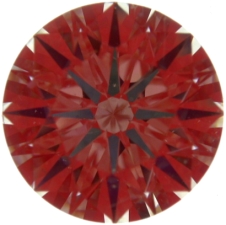 |
| 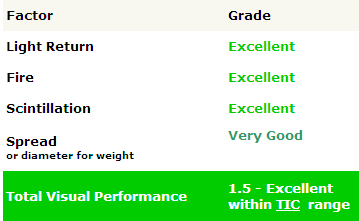 |
So ... for the most part this is all well and good eh? This assessment is accurate as we've personally confirmed it with a live analysis of the diamonds in question. Here is a photograph taken of these 2 diamonds in simulated diffuse daylight (GIA DiamondDock ™ ) which plainly demonstrates the optical characteristic of brightness. The difference is quite easy to see regardless of the size difference between these 2 stones.
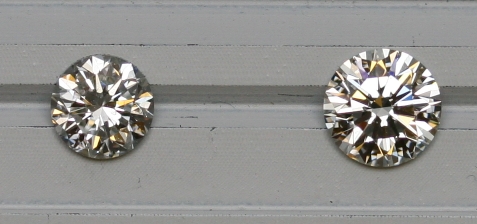
With this particular example the same is true regarding the optical characteristics as observed in spot lighting.
Here is a photograph of the same 2 diamonds taken in a spot lighting environment.
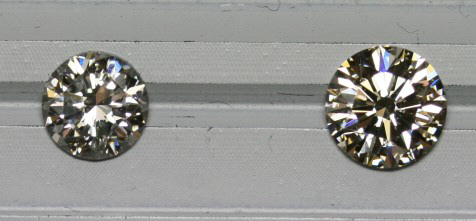
How the HCA Works and What it Attempts to Predict
The preamble to the HCA states "The HCA estimates a round diamonds appeal based on its potential ...
- - Light Return
- - Fire
- - Scintillation
- - Spread
A diamond getting a score of 0-2 is deemed to be "Excellent" and while it does state that most people prefer stones scoring in the 1-2 range, we find that most consumers natural tendency is to get the best HCA score they possibly can. As both a bricks and mortar store and an online retailer of diamonds many requests online come in for scores between 0-1 as these folks believe they are being even more selective. You will soon learn this is not necessarily the case regarding HCA scores and why.
Using the HCA requires the user to get some basic information about the diamond they are considering. Namely ...
- - The total depth percentage.
- - The table percentage.
- - Average crown angles or crown height. (angle measurements are more accurate)
- - Average pavilion angles or pavilion depth. (angle measurements are more accurate)
- - Culet size.
Below is a screen shot taken off the PriceScope website of the HCA software tool showing the user where to input the data.
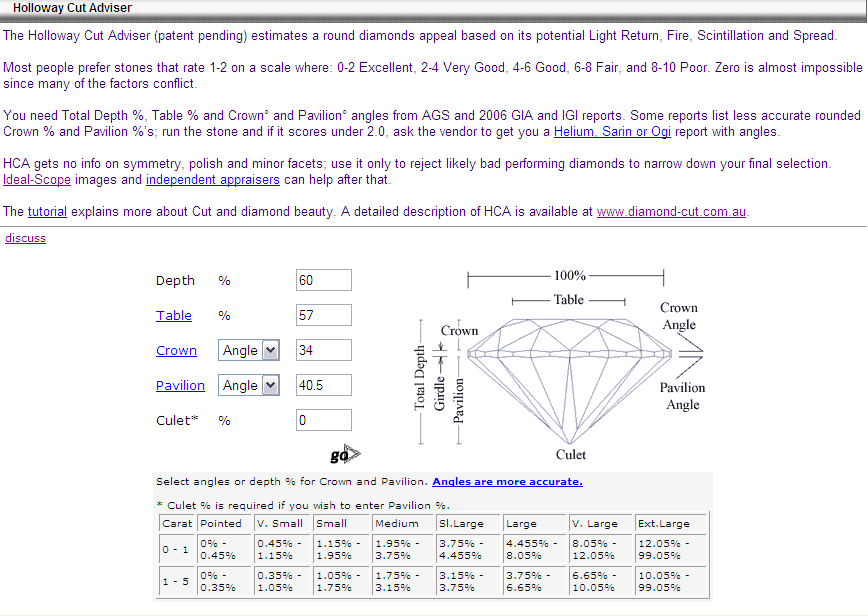
Prior to January 2006 you could not get this proportion information (primarily crown and pavilion angles) off of most lab reports and one would need a Sarin, OGI or Helium report which gave the measurements you needed to input into the HCA. As of January 2006 all GIA Reports include crown and pavilion angle data as well as other information needed to get HCA scores. While GIA does a small amount of rounding in their measurements it is generally not enough to impact the face up appearance of a diamond although it could dramatically impact the HCA score. (Note: The GIA Excellent Cut Grade does cover a certain variety of appearances which we further discuss in our article on the subject). Below is a chart showing diagrams on the various reports generated for diamonds wherein you can get the total depth, table size, average crown angles, & average pavilion angles needed to get an HCA score. On each of these diagrams you can find total depth %, table %, crown angles, pavilion angles and culet information.
| Portion of New GIA Report showing proportion data |
|
| Portion of an AGS Report showing proportion data | 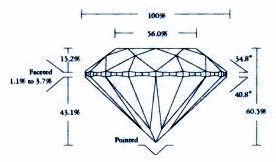 |
| One Sarin Report showing proportion data |
|
| Portion of OGI Report |  |
| Portion of Helium Report | 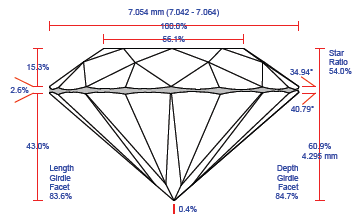 |
On the surface the HCA makes a lot of sense because there are many instances where diamonds that have great reflector images are indeed beautiful looking diamonds. The 2 example diamonds we showed above is a classic case in argument for the HCA. Garry has done a great job of establishing cut off points on the HCA for when leakage under the table becomes present in diamonds too. For sake of example we'll be using live stones and also simulated diamonds and graphics in DiamCalc to demonstrate this.
Many diamonds with shallow angled combinations are still bright and fiery while not making an GIA Excellent or AGS ideal Grade .
Recently we acquired the diamond below on the left which is a 1.01ct I VS2 which has a GIA Cut Grade of "Very Good" because of a few reasons (very thin girdle, good symmetry are two reasons), but the one of note being a proportion set which contribute to a decrease in optics in the GIA system. When we ran the diamond through AGS' official Performance Grading Software it scores an overall "1" for Light Performance taking a hit on the "Tilt" factor. While this diamond does not make ideal grade for Light Performance in both GIA and AGS Cut Grading systems, it scores a favorable 1.5 on the HCA. Here is a photograph under the GIA DiamondDock of this shallow angled combination alongside another diamond which also gets the GIA "Very Good" grade which has steeper/deeper angles. Two varieties of GIA Very Good's. In our observations the shallow angled stone on the left has the brighter appearance as we can observe greater brightness and contrast in it. The HCA scores for the following 2 stones are beneath.
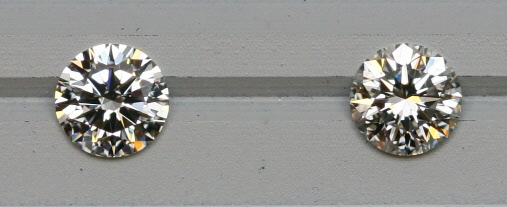 | |
| 1.01ct I VS2 shallow angled GIA VG | 1.03ct H SI2 steep angled GIA VG |
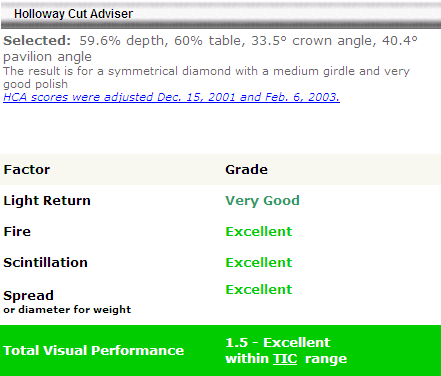 |
|
So this GIA Very Good/AGS 1 represents another good case for the HCA. We are in agreement that amongst the realm of GIA Very Good's the shallow angled combos are brighter and also more fiery than those of the steep/deep angled combinations. Another key point is that shallow angled diamonds will generally also have a better spread and the diamond will generally look larger than its actual weight. Here is a video comparison showing in more detail the optical characteristics and differences between these two GIA VG's as they are rocked at various angles in both diffuse and spot lighting.
The guarantee of solid or mostly solid red/black reflector images
Many ideal cut diamonds on the market today have crown angles in the 34.x° to 35.x° (although there are quite a few proportion combinations that produce ideal optics). When you couple those crown angles with pavilion angles at or over 41° leakage faintly begins to occur under the table. Here's an example generated within the DiamCalc software showing it. The diamond on the far left has ideal proportions and makes top grade in any system or technology. In the center stone we adjusted the pavilion angles from 40.8° to 41° and you can note more light pink as opposed to dark red under the table facet and the stone on the far right is beginning to get whitish under the table with a 41.1° pavilion angle. White = blatant leakage which generally occurs as angle relationships tend towards the steeper/deeper side. Note the decrease in the HCA scores as we adjust the pavilion angles from 40.8° to 41° to 41.1°.
| Ideal cut diamond with a 61% depth, 56% table, 35 ° crown angles and a 40.8° pavilion angle. | Same as left but with a 41° pavilion angle.
Note how the reds get slightly more pale under the table facet. | 35.1 crown angles, 41.1 pav angles & a 56% table. Leakage is more apparent under the table as observed in red reflectors. |
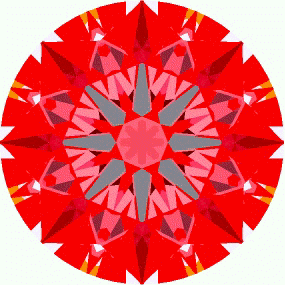 | 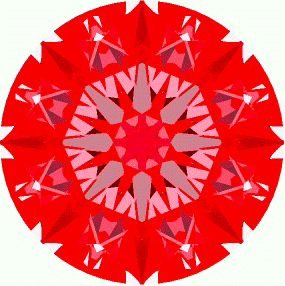 |
|
| HCA = 1.5 | HCA = 2.2
| HCA = 3
|
So ... the HCA sees this faint leakage under the table of the 2nd stone and gives it a hit of 2.2 taking it out of the Excellent range and into the Very Good rating and the score decreases as it goes to the 3rd stone with slightly steeper angles and a little bit more leakage.
Before we proceed to the limitations of the HCA, lets review it's strengths as covered thus far.
- - An Excellent HCA score (0-2) = an excellent reflector image.
- - An Excellent HCA score (0-2) = a diamond with minimal to no leakage via a reflector analysis, hence ...
- - The HCA offers a critical exam of what angle combinations produce leakage in diamonds (particularly under the table). Diamonds termed as "steep/deeps" (steep crown angles combined with steep pavilion angles produce leakage which the HCA easily and accurately identifies).
- - Many diamonds with excellent reflector images are good looking stones.
- - While the HCA favors non-AGS Ideal/GIA Ex shallow angled diamonds, it is this professional's opinion that these AGS Ex/GIA VG's are amongst the finest in their class (though not as bright as the best).
- - Excellent for determining diamond appearance in spot lighting environments (fire) even if the diamond suffers in brightness.
The question that begs an answer then is "Do the seemingly best FireScope images always translate into the most beautifully cut diamonds?" And ... "Is this leakage which is visible under a reflector (foundation for HCA scoring), discernable to human eyes?" If the answer to any of these questions are "no", then there are some apparent kinks in the system that consumers who consult this tool need to be made aware of as well.
Diamonds with 41° pavilion angles (and even slightly over) are among the most beautifully cut diamonds in the world (when coupled with appropriate crown angles). Above we were examining how HCA scores got worse as leakage became more apparent when observed through red reflectors. According to both GIA and AGS laboratories (2 of the most renown and conservative labs in the world) the diamond in the above table with 35 degree crown angles and 41 degree pavilion angles (which gets a so-so HCA score of 2.2) consider this as a top grade and displays what is perhaps some of the best optics to be seen in round brilliant cut diamonds. In the above example the ever so faint amount of leakage in the center diamond and the diamond on the far right is impossible, I repeat, impossible to discern with human vision in any lighting environment you bring the diamond into. It is only something that can barely be seen under a red reflector and even at that it is still very difficult. Take this real diamond below as an example. It serves to demonstrate a few limitations of the HCA. Below are the proportional measurements as per a GIA FacetWare Report which does reflect a slight degree of rounding. It is a 1.89ct G Si1.
Here are the diamonds proportions as reported via GIA FacetWare which are also reflected on GIA Reports alongside it's actual red reflector image.
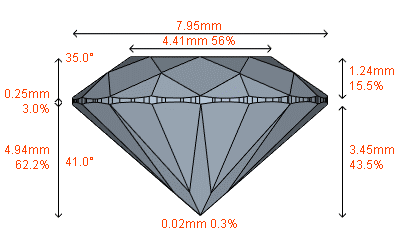 |  |
When you input these parameters into the Holloway Cut Advisor here are the results.

If one were looking at a GIA Report or GIA FacetWare scan and inputting the numbers into the HCA this would turn off most consumers shopping for a superior cut quality. After all, superior cut offers supreme beauty in diamonds. With ratings of Excellent, Very Good, Good, Fair and Poor nothing about this stone is
Excellent according to the HCA. :-S This is sad because folks could be passing up a perfectly beautiful diamond based on this faulty information.
Our independent research has determined that with a 35 degree crown angle, leakage is not visible to human perception until the pavilion angles reach 41.4 degrees (November 06).
Even when we use the more precise measurements of the diamond via the Sarin analysis, the stone still scores over a 2.0. The more precise measurements are under the column "Measured Value" in the graphic below.

Here are the more accurate HCA Results based on actual measurements of Sarin and
not rounded with GIA's calculations.

Before we examine the visual differences alongside another comparable clarity/color/carat weight, take note that in the graphic above the HCA is indicating that this diamond would not make AGS Ideal Grade for light performance when in fact it does and is an actual AGS Graded Ideal Cut.
The HCA attempts to predict potential GIA/AGS grades when it is possible that the diamond in question is perfectly fine, even with a score over 2.0.
So one serious limitation of the HCA is that this HCA 2.3/2.1 (depending on which Report's numbers you input) happens to be as bright as as stones scoring under 2 (and in some cases even brighter!). Here is a graphic side by side of this 1.89ct G Si1 alongside a comparably sized 1.84ct F VS2 diamond which scores a 1.1 on the HCA.
| 1.84ct F VS2 HCA 1.1 | 1.89ct G SI1 HCA 2.3/2.1 |
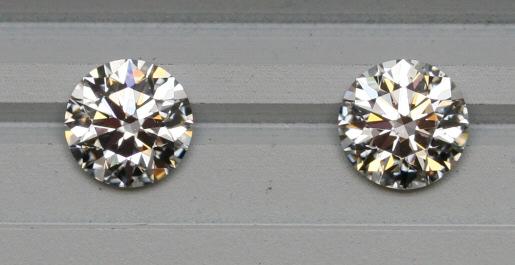 | |
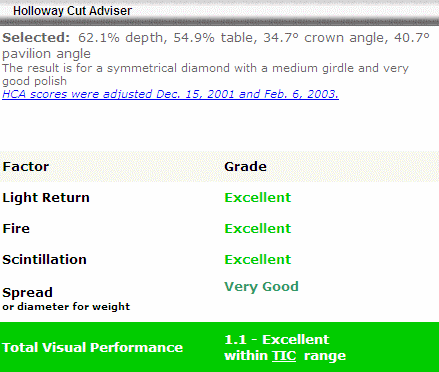 |  |
To view a video of this comparison under diffuse lighting (for brightness) and spot lighting (for fire) click here.
Using the same diamond as an example, let's look at limitation #3 of the HCA.
The HCA score on a diamond can change on the same stone depending on the Report or Scanner providing the information.
In the recent past we had a diamond in with the following measurements. It was a 1.40ct G VS1. Below are its measurements via GIA. A Sarin Analysis and then the OGI Analysis. (3 separate diamond scanners).
| Measured Proportions | HCA Results | |
| GIA Measurements (slightly rounded). |  |  |
| The same diamond as measured by the Sarin Machine. | 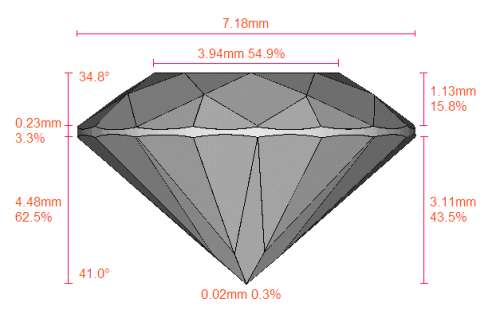 | 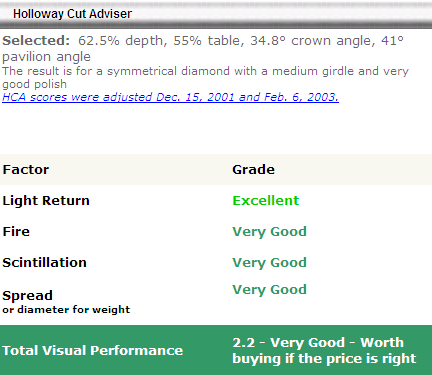 |
| The same diamond as measured by an OGI Scanner. | 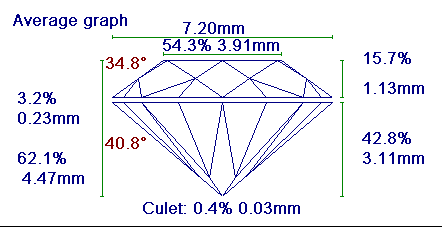 |
|
Here you can see results on the HCA vary on the same stone from a "Very Good" 2.3 (all "very good" and nothing "excellent") to an Excellent 1.5 (with 3 Excellent and 1 Very Good). Have the optics of the diamond changed because of which scanner was used? Absolutely not. The diamond also falls in GIA Ex/AGS Ideal classification and is a rare, bright, beautiful diamond. This fallacy leads to limitation #4.
The HCA does not take into account the variances of the facet measurements on which a diamond is cut. Examining the variances on a diamond is one way that shows the gemologist and the laymen the level of precision to which a diamond has been cut which can be examined numerically and based upon an accurate scan of the diamond being analyzed. Take the diamond below. A 1.34ct E VS2 which we examined.
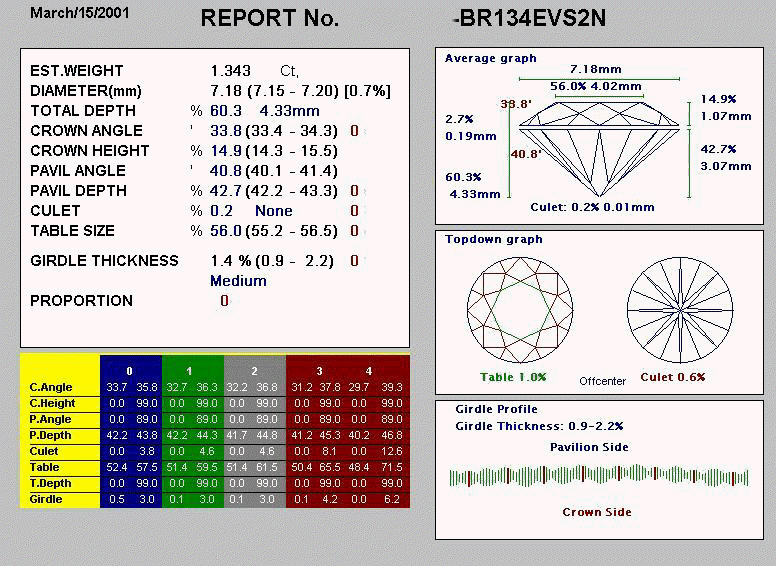
Note the variances for the measurements on each major facet set. There is a .9° degree variance from minimum to maximum crown angles. A 1.3° variance from min to max on the pavilion angles and a 1.3° variance on all table measurements. While this doesn't seem like a lot of variance on the surface, when you're talking about diamonds IT IS A LOT.Facets measured
Variance or difference from minimum to maximum
crown angles (33.4 - 34.3)
.9º
crown height (14.3 - 15.5)
1.2%
pavilion angles (40.1 - 41.4)
1.3º
pavilion depth (42.2 - 43.3)
1.1%
table % (55.2 - 56.5)
1.3%
culet off centered
.6%
table off centered
1.0%
Note this diamond for comparison.
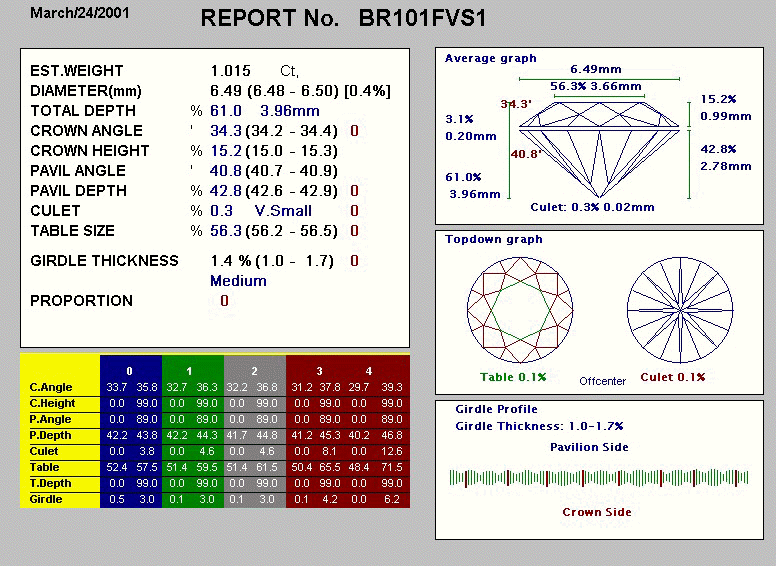
Facets measured
Variance from min to max
crown angles (34.2 - 34.4º)
.2º
crown height (15.0 - 15.3%)
.3%
pavilion angles (40.7 - 40.9°)
.2º
pavilion depth (42.6 - 42.9)
.3%
table % (56.2 - 56.5&)
.3%
culet off centered
.1%
table off centered
.1%
Note how tightly the variances are on this diamond when you take into account minimum/maximum measurements. No comparison between the 2 when it comes to precision. This diamond is cut to a MUCH tighter level of precision which the HCA does not tell you. This limitation which can be examined in the numbers can also directly impact Limitation #7.
The HCA is strictly a predictor of light performance and is not an actual examination of the diamond in question.
This can't be stressed enough. Nothing and I repeat NOTHING takes precedence over a physical examination of the diamond being analyzed by a professional who knows how to accurately grade and assess light performance. There are a few technologies available to the professional today for determining light performance within diamond. While many of these technologies are good, it is our opinion that nothing supersedes a physical examination of the diamond under the appropriate lighting environments but even if a technology such as the HCA is going to attempt to predict light performance it should be considered that the HCA is only taking into account Limitation #5.
The HCA only takes into account the average angle measurements of only 17 out of a total of 57 facets for its prediction. (or 18/58 if there is a culet facet).
Those facet sets being… | The facets the HCA is not taking into account | |||
 | a. The Table: Average of 4 table measurements. (1 table facet)
| 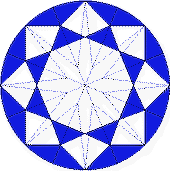 | d. 16 upper half facets.
e. 8 star facets | |
 | c. Average of 8 pavilion angle measurements. (8 pavilion main facets)
1 table | 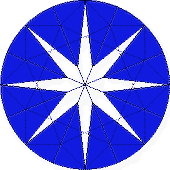 | f. 16 lower half facets.
| |
These facet sets that are not taken into account impact the appearance of a round brilliant cut diamond with regards to the nature of its scintillation and also its overall light performance. Altering the upper and lower half facet angles impacts brightness that is discernable to the human eyes and is covered in more detail in our chapters on painting and digging. Altering lower half and star length impacts the type or nature of scintillation that can be observed within diamond (broad flash vs pin flash). For a full discussion on scintillation and how these facet sets alter diamond appearance please see our video on the subject " The Nature of Scintillation".
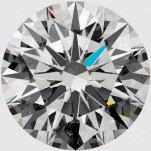

For arguments sake these 2 simulated diamonds have identical crown angle, pavilion angle, table size and total depth measurements yet vary in their appearance due to minor facet construction. Both have 57% tables, 40.75° pavilion angles and 34.5° crown angles. The differences in appearance are due strictly to altering the lower half and star length. Facets that are not taken into account with the HCA.
Considering that the HCA only takes into account the averages of only 17 of 57 facets leads to HCA limitation #6.
The HCA assumes precise optical symmetry when in fact less than 1% of diamonds in the world are cut to that level of precision.
For a full discussion on the subject of optical symmetry and how it relates to craftsmanship I refer you to our tutorial on the subject
HERE. In short and using our GIA 1.89ct G SI1 as an example (the diamond that got the 2.3 HCA score), here is a comparison of that diamonds optical symmetry as observed in our DiamXray technology alongside another more commonly cut ideal diamond. We personally grade for Optical Symmetry which refers to the patterning which results in a very symmetrically cut diamonds (Hearts & Arrows diamonds are one form of patterning which has grown popular on the net). On a grading scale of Superior, Premium & Traditional the diamond on the left achieved our grade of Superior while the stone on the right is common or more traditional. Less than 1% of diamonds in the world are cut to the level of precision as displayed with the diamond on the left. If one were looking at HCA scores alone of the following 2 diamonds one would be lead to believe the diamond on the right was superior when in fact it is a more sloppily cut diamond and is not more brilliant or fiery than the diamond on the left.
| HCA 2.3 | HCA 1.1 |
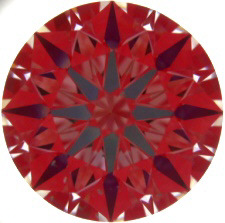 | 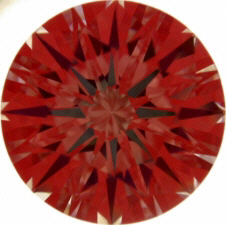 |
Since does not take 40 of 57 facets into account it does not take into account the cutting features of painting and digging which are minor facet deviations in the cutting of the upper and/or lower girdle facets. How this impacts the optics of a diamond are notable enough to cause it to not make the GIA Excellent cut grade as well as the AGS Ideal cut grade. (Note: There are different thresholds regarding the amount of painting and digging allowable in each of the GIA and AGS cut grading systems for their top grade.) The examples used below are diamonds that don't make either GIA Excellent Grade in both painting and digging while in AGS' system, the painted girdle diamond does make Ideal grade and is an example of digging the upper girdle facets. While there are various ways of being able to detect these features in girdle cutting we've included the results via the Helium Report for a quick evaluation. To learn more about painting and digging of the girdle facets we refer you to our more in-depth article here.
In the chart below are the proportional measurements of each diamond, its HCA score then a photograph taken under simulated diffuse daylight alongside the diamond on the far right which gets an HCA of 2.1 (2.3 if using GIA's measurements).
Dug out diamond (GIA Vg/AGS 1) | Painted girdle diamond (GIA VG/AGS 0) | Classic girdle cutting (GIA Ex/AGS 0) | |
Proportions | 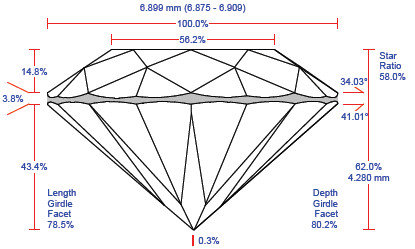 |  |  |
Helium paint/dug results |  |  |  |
HCA
|  | 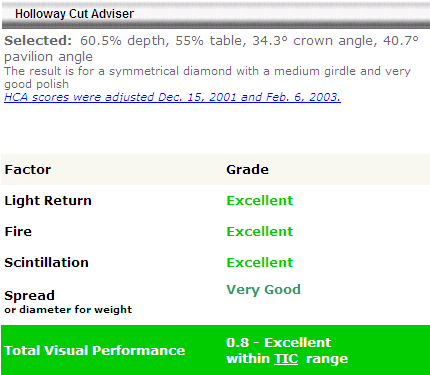 | 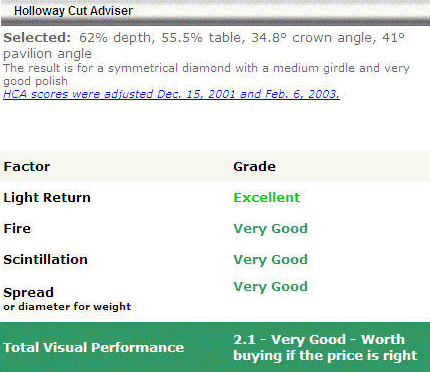 |
Photography | 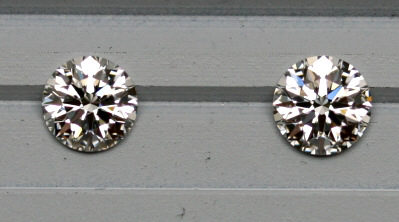 | 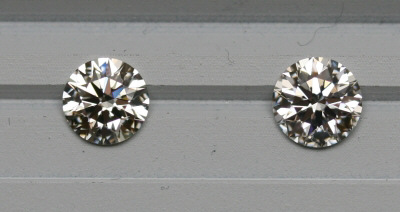 | Each of the graphics on the left are showing this diamond (specs above) which is on the right hand side in each of the pictures. A decrease in optics can be seen in both the dug out stone and the painted stone as exhibited by the presence of more dark areas than there are bright reflections of white light. This is yet another instance where a GIA Ex/AGS Ideal with an HCA score >2 is brighter than these stones with HCA scores < 2. |
To view a video of this comparison click here. | To view a video of this comparison click here. |
The HCA favors shallow angled diamonds even when they don't make GIA Ex/AGS Ideal grade.
This is one of those instances that reflect one of Garry's personal preferences even when trade and majority opinion run counter to the advice suggested by the HCA. This is, in my professional opinion a major drawback of the HCA because it highlights the point that the software is based entirely on one man's individual preferences (Garry's) and not the opinion of most including myself who are particular about selecting diamonds with top optical properties. Since the HCA was released the Gemological Institute of America has also released a Cut Grade Estimator called FacetWare
™
which examines not only the 17 main facets that the HCA does but also the star facets and lower halves (41 of 57 facets). Besides this, one of the other main differences between the results garnered from the GIA FacetWare as opposed to the HCA is that the FacetWare
™
results are based on the observations of hundreds of people with real diamonds in common viewing environments while the HCA reflects the opinions of only one person and his individual/personal interpretation of reflector based imagery.
Ok ... so lets take a critical look at an "excellent" scoring HCA diamond that ranks amongst the top scoring diamonds on the HCA that most observers and the 2 most conservative labs disagree with Garry on. This examination is critical because it will help us to understand what Garry likes that most observers do not.
We recently acquired a diamond with the following data and results.
| Proportions via Helium Scan | DiamXray Analysis | |
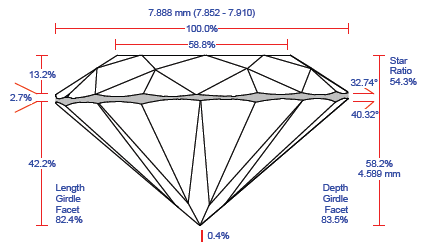 | 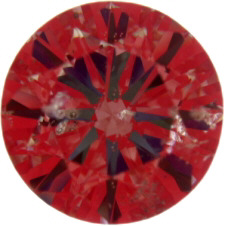 |
AGS Performance Grading Software results on this diamond.(Note: Although this diamond received polish/symmetry grades of Good/Good I entered "Ideal/Ideal" so that we could examine strictly the "Light Performance Results" of the diamond). |
 |
In summary. Viewing the data above on this shallow angled HCA of 1.5, GIA gives it a "Very Good" and AGS gives it a deduction of "5" for light performance with the biggest hit being in way of the "Contrast" metric. Ie. The diamond lacks contrast. Interestingly there is a direct correlation with this metric and the DiamCalc metric for "Dark Zone" which was formerly called "Contrast" in prior versions of their software. We will be making a comparison with both photography and video of this diamond alongside one of the other example stones we've been using in this tutorial, namely the 1.89ct G SI1 with an HCA over 2.0.
Perhaps this is the first time I'm bringing up the DiamCalc software results in this tutorial but we have been noting correlations between DiamCalc results and visual observation for a while now. Earlier last year (in 2005) when we did our review of the GIA Cut Grading System we noted a direct correlation between the various GIA Cut Grades and the Contrast metric in the DiamCalc software. Results that can also be
seen virtually through the DiamCalc/Gem Advisor software "Office Lighting View". Below is a demonstration of the comparison we'll be making with photography & video except here are the DiamCalc results.
| DiamCalc Metric | 1.89ct w/HCA >2 | 1.73ct w/HCA of 1.5 |
| Office Lighting |  | 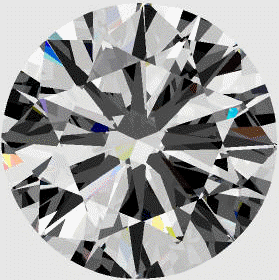 |
| DiamCalc Cut Quality Results
(note the lower "dark zone" score. This is the red flag we see which correlates to the AGS Contrast metric) | 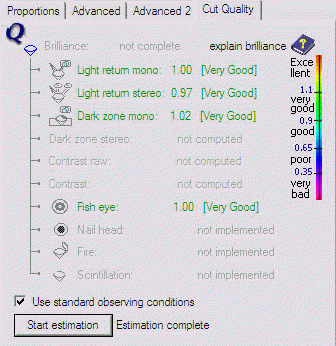 |
|
Note when you compare the 1.89ct with the 1.73ct in the simulated "Office Lighting" you can note more areas of darkness and less bright reflections in the 1.73ct. Here are those graphics scaled down. for a side by side comparison. The diamond on the left is what makes GIA/AGS' top grade for Light Performance while the diamond on the right fails in both systems for top optics (and for good reason we believe).


Here is a photograph of the same 2 diamonds taken under the GIA DiamondDock simulated diffuse daylight view. Can you pick out which diamond is which based on the graphics above? I think it'll be easy for ya. ;) The comparison of the DiamCalc Office Lighting View and the DiamondDock simulated diffuse daylight view (live) we have found to have the closest corelations when it comes to real world observations of the optical characteristic of brightness. At least these have been my observations.

Here's the same graphic blown up to show more detail.
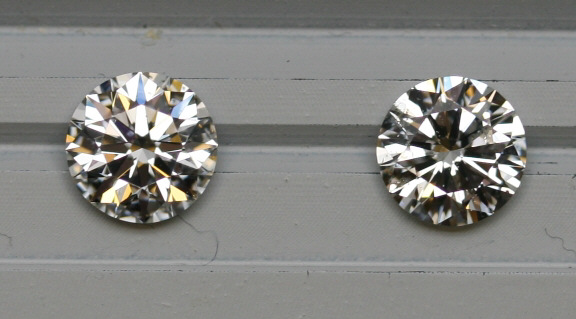
Note: While the shallow angled diamond above suffers in diffuse day lighting environments (both simulated and natural) the diamond does happen to excel in direct/spot lighting environments (exhibiting fire/scintillation characteristics). In our professional opinion, for a diamond to be considered as having top optics or Ideal/Excellent light performance it must excel not only in spot lighting but also natural day lighting as well.
The HCA "Spread" factor is extremely restricting.
On the HCA score one of the 4 factors it looks at is "spread". Spread relates to how big the diamond looks for its given measurements and has a direct relationship to the "total depth percentage" measurement of a diamond. Put more simply, the shallower a diamond is cut the larger it looks. Conversely the deeper it is cut the smaller it will look in its face up appearance. While it is true that the shallower cut diamond will larger it will look for its weight, the HCA penalizes many diamonds that have a perfectly normal spread for their carat weight.
For a basic understanding of spread, I've provided in the graphic below is a great example of how total depth % in a round brilliant cut diamond impacts its face up appearance. Both of the diamonds in the photograph below weigh exactly the same and are 1.01ct in weight. The diamond on the left is what is considered a commercial diamond and has a total depth percentage of 64.6%. The diamond on the right falls in the zenity of GIA Excellent/AGS Ideal and has a total depth percentage of 61.1%
| 1.01ct w/64.6% depth. | 1.01ct w/61.1% depth |
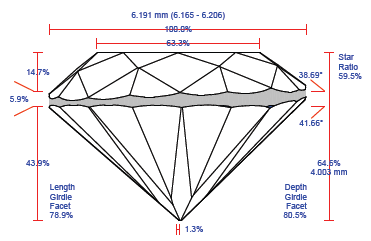 | 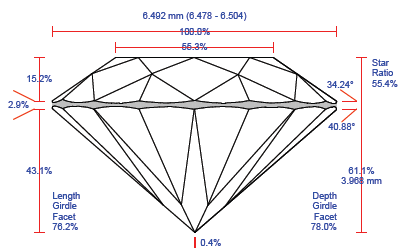 |
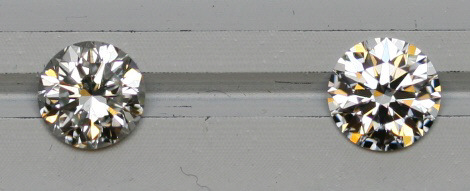 | |
| While there is a notable difference in the brightness between the 2 diamonds above, what we are noting here is the visual size difference between the two diamonds. The graphic is blown up to show more detail. Not only is the diamond on the right brighter but it's diameter and visual size is notably larger. Ie. it has a better spread. The graphic below is scaled down. | |
 | |
 | |
Ok. Now that we understand spread lets take a closer look at stones that begin to take hits on the HCA.
On the HCA diamonds begin to take a hit in spread at a depth percentage of 60.4%. Below is a comparison of 2 diamonds that have identical measurements except for .1% in their total depths on the HCA. For sake of simplicity I used Tolkowsky ideal proportions (55% table, 40.8 pavilion angles and 34.5 crown angles) only changing the total depth by .1%.
 | 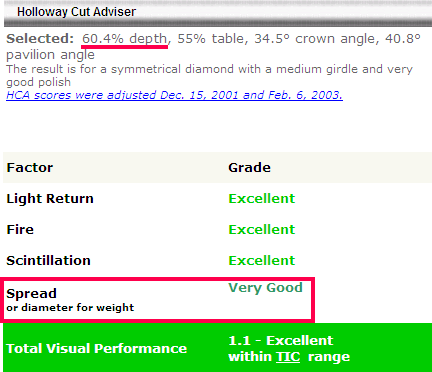 |
The two most conservative labs grading cut (GIA and AGS) begin to penalize for spread once the depth hits at our around 63% which most consider a reasonable cut off. Is the HCA being more strict or unreasonable? In the opinion of most professional's the answer is unreasonable. There are thousands of beautifully cut diamonds that have depths greater than 60.3% and up to the 62.x% range which are perfectly fine, look the proper size for their weight and are not disproportionate in any way.
Below are simulated graphics akin to the example I used above to show size differences. The graphics are blow up to the size of roughly a 20ct diamond to help make it easier to see.
In the trade certain professional's have what they consider to be their "cut offs" and we most certainly have tolerances we abide by regarding the quality of the diamonds we feature and very particular about the cut qualities we deem as worthy to make it into our inventory. While we respect Garry's personal opinion on the Spread grading in the HCA it is important for the consumer to understand that this is yet another instance where the HCA reflects Garry's personal opinion/interpretation that does not agree with most professional's and more notably does not agree with GIA and AGS' considerations of this feature.
 | Same example as above. 64.6% next to 61.1%. We can most definitely note the difference in size visually. |
 | This comparison is a diamond with a total depth of 60.3% next to one with 61.1% depth. No notable difference in size. |
 | A 60.3% depth alongside a diamond with 62.5% depth. Perceptible but not easy. |
If there were strong merit to it I would not have bothered writing about it but since we get questions from consumers on it I thought it best to address it in this article, especially for those who are being particular about getting 4 Excellent's with an HCA score.
Conclusion:
There are many instances when the HCA is accurate but there are also many instances when it isn't. While the HCA is sensitive about eliminating angle combinations that produce leakage under the table (steep/deep angle combos) it doesn't discern or give accurate break points where leakage impacts actual "Total
Visual Performance" (ie. when leakage is discernable to the human eyes). So there are angle combinations that take a hit on the HCA (some used in this article) for Total Visual Performance and the leakage is impossible to discern with the eyes and in some cases even hard to discern under reflector based technologies such as the IdealScope/DiamXray/ASET .
On the flip side the HCA is not sensitive to shallow angled combinations but reflects Garry's personal preference towards these diamonds. There are shallow angled combinations that are more attractive than others however when it comes to actual "Total Visual Performance" the HCA doesn't do that good of a job separating amongst these shallow angled combos and the actual break points where shallow angles actually do impact face up appearance. This is particularly true regarding diamond optics in daylight environments which happen to be some of the most common viewing environments people find themselves in daily.
When a diamond falls within the threshold of GIA Ex
and AGS Ideal for "Light Performance" and the HCA gives it a score over 2.0 we are finding the HCA to be in error each time. As daily buyers and traders of some of the finest diamonds in the world, it's neat to know what the HCA score is (and many of our diamonds score =< 2.0) however we never let it dictate our purchasing decisions and neither should it be for the end consumer. When you have the tools and expertise of a professional's live analysis, this takes precedence over a prediction any day. Considering the amount of instances where diamonds with scores > 2 are more beautiful than many combo's with diamonds that score < 2 we suggest the following procedure to the amateur seeking to use this tool in their purchasing decision if indeed they are seeking beautifully cut diamonds.
Firstly seek out GIA graded "Excellent" cuts = > January 2006 or AGS Ideal Cuts accompanied with the "new" grading Reports that take "Light Performance" into account => June 2005. AGS, at this time is issuing both older and newer Lab Reports upon the request of the manufacturer so if looking for AGS graded diamonds look for the ones with the "Light Performance" metric.
- If the GIA Ex or AGS Ideal scores under a 2.0 HCA no prob.
- If the GIA Ex or AGS Ideal scores over a 2.0 don't be quick to "weed it out". There are angle combinations that score over a 2.0 that are just fine.
On a personal note, we use the most stringent criteria for determining top optics in diamonds and 99% of our inventory falls within the zenith of GIA and AGS top grade for light performance. If you're going to deviate away from either labs specs for their top grade we recommend seeing it alongside one that does especially if you're going to put heavy emphasis into a particular technology (HCA, Ideal-Scope, BrillianceScope, etc.).

